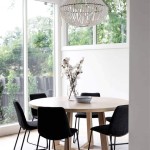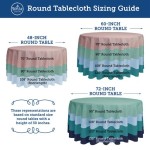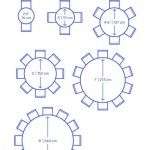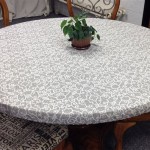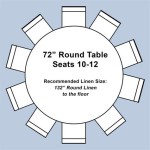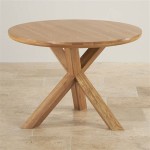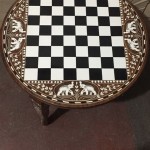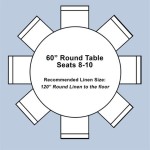How to Use a Tablecloth as a Backdrop for a Wedding Party
Creating a visually appealing backdrop is crucial for any wedding party, serving as a focal point for photographs, presentations, and general ambiance. While professional backdrops can be expensive, a tablecloth offers a cost-effective and versatile alternative. This article outlines the steps and considerations involved in using a tablecloth as a backdrop, ensuring a aesthetically pleasing and functional result.
Selecting the Appropriate Tablecloth
The initial and arguably most important step is selecting the right tablecloth. The properties of the tablecloth will directly impact the overall appearance and suitability for the intended purpose. Several factors must be considered, including material, size, color, and texture.
Material: Tablecloths are available in a variety of materials, each with its own set of advantages and disadvantages. Linen, for example, offers a classic and elegant look, but is prone to wrinkling and may require professional cleaning. Cotton is a more affordable and easily maintained option, but can also wrinkle and may lack the visual richness of linen. Polyester is wrinkle-resistant, durable, and cost-effective, making it a practical choice for budget-conscious events. Satin provides a luxurious sheen and adds a touch of glamour, but requires careful handling to avoid snags and stains. Consider the overall aesthetic of the wedding party and choose a material that complements the theme.
Size: The size of the tablecloth is critical to ensure adequate coverage. Measure the area where the backdrop will be placed, taking into account both width and height. The tablecloth should be significantly larger than the desired backdrop dimensions to allow for draping and securing. A tablecloth that is too small will appear stretched and inadequate, detracting from the overall appearance. For example, if the backdrop frame is 8 feet wide and 8 feet high, a tablecloth that is at least 10 feet wide and 10 feet high is recommended to allow for proper draping and attachment.
Color: Color plays a significant role in setting the mood and complementing the wedding party's color scheme. White or ivory tablecloths create a clean and classic backdrop, suitable for a wide range of themes. Colored tablecloths can add a pop of vibrancy or complement specific color palettes. Dark colors tend to absorb light, while light colors reflect it, impacting the overall brightness and visual impact of the backdrop. Consider the lighting conditions of the venue and choose a color that enhances the desired ambiance. It is also important to consider how the color will interact with the attire of those who will be standing in front of the backdrop; avoid colors that clash or blend in too much.
Texture: The texture of the tablecloth adds depth and visual interest to the backdrop. Smooth fabrics like satin or polished cotton offer a sleek and modern look, while textured fabrics like lace, brocade, or damask add a touch of sophistication and elegance. Sequined tablecloths can create a glamorous and eye-catching backdrop, but may be overwhelming if not used sparingly. Consider the overall theme of the wedding party and choose a texture that complements the desired aesthetic. Avoid textures that are too busy or distracting, as they can detract from the subject of the photographs.
Preparing the Backdrop Structure
A well-constructed backdrop structure is essential for creating a stable and aesthetically pleasing display. Several options are available, ranging from simple DIY solutions to more elaborate, professionally-built frames. The choice depends on budget, skill level, and the desired level of sophistication.
Pipe and Drape Systems: These systems are commonly used for event backdrops and offer a professional and adjustable solution. They consist of vertical poles, horizontal crossbars, and weighted bases. The height and width of the backdrop can be easily adjusted, making them versatile for different spaces. Pipe and drape systems are relatively easy to assemble and disassemble, making them a convenient option for temporary installations. They can be rented from event rental companies or purchased outright.
DIY Frames: For a more budget-friendly option, a DIY frame can be constructed using readily available materials. PVC pipes and fittings can be used to create a simple and lightweight frame. Wooden frames can be built using lumber and basic carpentry tools. The frame should be sturdy and stable enough to support the weight of the tablecloth and any additional decorations. Ensure that the frame is properly secured to prevent it from tipping over, especially in windy conditions. Considerations to be made for materials include choosing weather resistance materials for outdoor environments.
Existing Structures: In some cases, existing structures can be repurposed as a backdrop. A blank wall, a doorway, or even a large piece of furniture can be transformed into a backdrop with the addition of a tablecloth. Ensure that the structure is stable and provides adequate support for the tablecloth. If using a wall, consider adding hooks or clips to securely attach the tablecloth. Evaluate the existing color and texture of the structure to see if it complements or clashes with the tablecloth chosen. Background lighting may be needed to highlight the backdrop.
No matter the type of the frame chosen, it is crucial to ensure its dimensions are suitable for the tablecloth selected. Allow for overlap so the tablecloth can be secured to the frame without appearing stretched. The frame should also be stable enough to support the weight of the tablecloth without wobbling or collapsing.
Securing and Styling the Tablecloth
Once the backdrop structure is in place, the tablecloth needs to be securely attached and styled to create the desired look. There are several methods for securing the tablecloth, each with its own advantages and disadvantages. The choice depends on the type of frame, the material of the tablecloth, and the desired aesthetic.
Clips and Pins: Clips and pins are a simple and effective way to secure the tablecloth to the frame. Binder clips, clothespins, or safety pins can be used to attach the tablecloth to the frame at regular intervals. Ensure that the clips or pins are strong enough to hold the weight of the tablecloth and prevent it from slipping. Hide the clips or pins behind the fabric for a cleaner look. Be careful when using pins on delicate fabrics, as they can cause damage. Consider using specialized fabric clips that are designed to hold fabric without damaging it.
Velcro: Velcro offers a more secure and semi-permanent attachment method. Strips of Velcro can be attached to both the tablecloth and the frame, allowing for easy attachment and removal. Velcro is particularly useful for heavier tablecloths or in situations where a more secure attachment is required. Ensure that the Velcro is securely attached to both surfaces using strong adhesive or stitching. This method creates a clean finish, as the velcro strips are hidden behind the fabric. The ease of removal also makes this method environmentally friendly.
Draping and Folding: Draping the tablecloth over the frame can create a soft and elegant look. Allow the tablecloth to cascade down the sides of the frame, creating natural folds and pleats. Add additional folds or pleats to create visual interest. Experiment with different draping techniques to find the look that best suits the wedding party's theme. Incorporate lighting to highlight the folds and textures of the tablecloth. Consider gathering the fabric using ties or ribbons to create different shapes and textures. This method is particularly useful when securing the tablecloth to an existing structure. Weight the bottom of the tablecloth to prevent it from blowing in the wind.
Beyond securing the tablecloth, the styling is equally important. Ironing the tablecloth before hanging will remove any wrinkles and create a smooth, professional look. Consider adding additional decorations, such as flowers, lights, or ribbons, to enhance the backdrop. Ensure that the decorations complement the tablecloth and the overall theme of the wedding party. Test the appearance of the backdrop under different lighting conditions to ensure that it looks good in photographs and in person. Adjust the draping and styling as needed to achieve the desired effect.
In applying these methods, it is critical to test any modifications in advance. For example, a test run of the frame setup can prevent unexpected issues on the wedding day. This includes verifying that the tablecloth fits the frame, the chosen attachment method works effectively, and the overall appearance is satisfactory. Such precautionary measures contribute to a smooth and successful backdrop installation for the wedding party.
How To Make An Easy Diy Party Backdrop

Photo Booth Backdrop Makoodle

Fabric Backdrop
How To Make An Easy Diy Party Backdrop

How To Diy D For Wedding Reception Why It Matters Cv Linens

Elegant Fabric Backdrop Al For Your Venue Elevated Events

Diy Plastic Tablecloth Backdrop Created By New Era Wedding Event Planning

Elegant Fabric Backdrop Al For Your Venue Elevated Events

Plastic Tablecloth Backdrop Easiest Diy

Wedding Linens Where To Buy Or What Know
Related Posts

